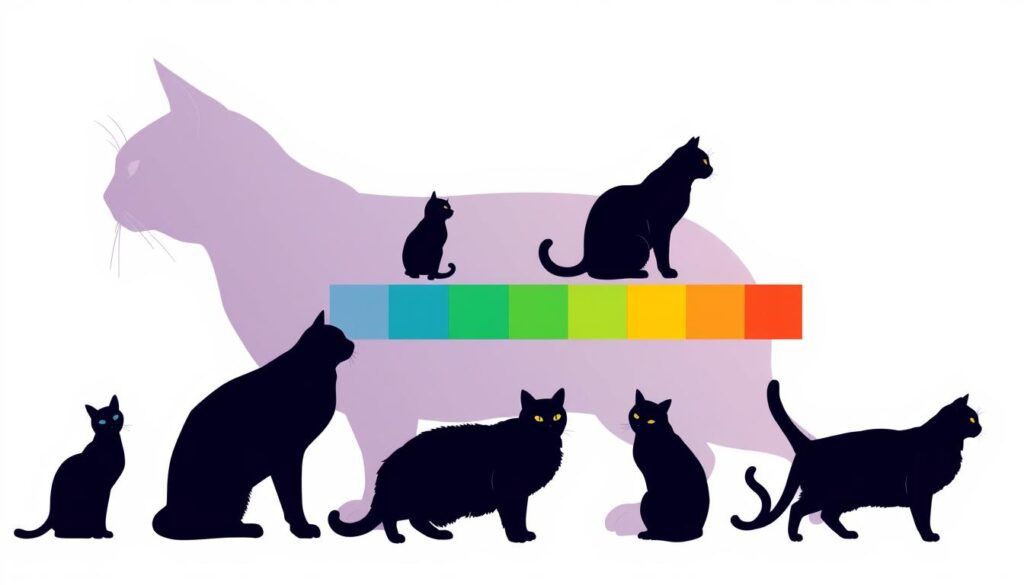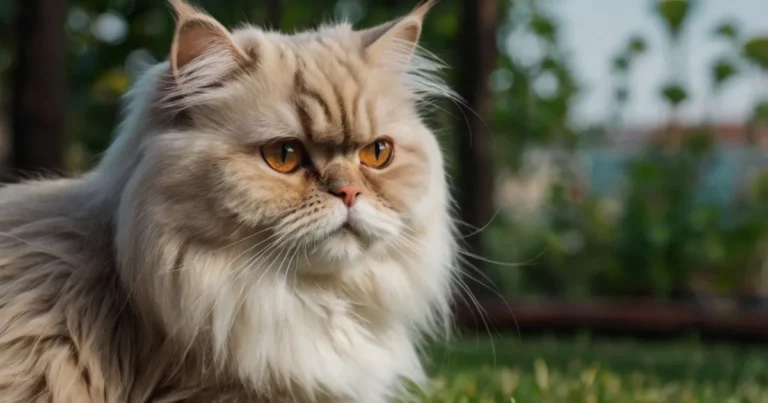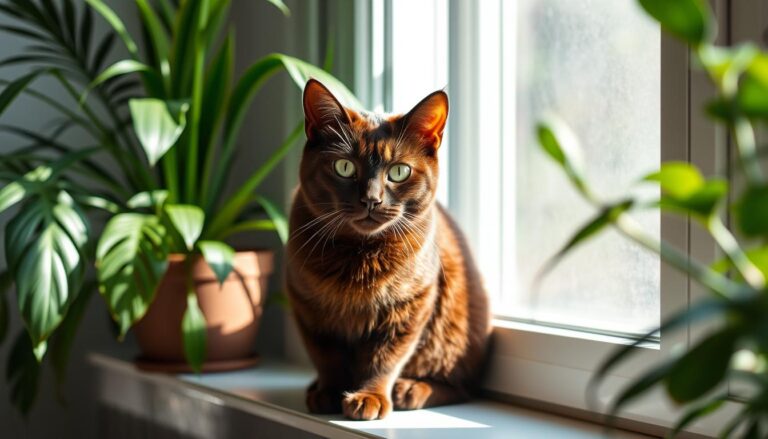Normal Cat Weight : How to Tell if Your Cat’s Weight Is Healthy
As a devoted cat parent, you want your feline friend to be healthy and happy. But, with over 61% of cats in the U.S. being overweight or obese, it’s key to know the normal weight range. This guide will help you understand what makes a cat healthy, offer tips for managing their size, and show you how to keep your cat at their best.
Knowing your cat’s normal weight is the first step to their health. A typical healthy weight for a domestic cat is between 8 to 12 pounds. But, age, breed, and gender can affect a cat’s ideal weight. Learning about these guidelines will help you ensure your cat is at their healthiest.
Table of Contents
How Much Should a Cat Weigh?
Finding the right weight for your cat can be tricky. It depends on their age, breed, and gender. Knowing the typical weight ranges for cats helps keep them healthy.
Cat Weight Chart by Age
Kittens under 1 year old usually weigh 5-8 pounds. Adult cats, 1-2 years old, weigh 8-9 pounds. Kittens grow about 100g each week until they reach their adult weight, usually by 44 weeks.
Cat Weight Chart by Breed
Different cat breeds have their own weight ranges. Smaller cats like Siamese weigh 5-10 pounds. Big breeds, such as Maine Coons, can reach 25 pounds. For example, female British Shorthairs weigh 3.1-6.8 kg, and males weigh 7-15 lbs.

Typical Weight Range for Male vs Female Cats
Male cats usually weigh more than females. Male domestic cats can weigh 11-15 pounds. Females typically weigh 8-12 pounds. But, weight can vary based on the cat’s build and health.
To check if your cat is at a healthy weight, talk to your vet. Use a cat weight chart as a guide. Keeping your cat at the right weight is key for their health and can prevent serious problems later.
How Health Issues Impact Cat Weight
Keeping a healthy weight is key for cats. But, health problems can upset this balance. Issues like arthritis, hypothyroidism, and acromegaly can cause weight gain. On the other hand, problems like inflammatory bowel disease, hyperthyroidism, and dental disease can lead to weight loss.
It’s important to watch your cat’s eating, activity, and overall health. Sudden weight changes might mean a serious health issue. You should get your cat checked by a vet if you notice these changes.
Health Problems in Cats That Cause Excess Weight
- Arthritis – Painful joints make it hard for cats to move and exercise, leading to weight gain.
- Hypothyroidism – This thyroid gland disorder slows down the cat’s metabolism, causing weight gain.
- Acromegaly – This rare hormonal disorder can cause excessive growth and weight gain in cats.

Feline Health Conditions That Contribute to Weight Loss
- Inflammatory Bowel Disease (IBD) – This chronic gastrointestinal condition can impair nutrient absorption and cause weight loss.
- Hyperthyroidism – An overactive thyroid gland can dramatically increase a cat’s metabolism, leading to dramatic weight loss.
- Dental Disease – Painful dental problems can make it hard for cats to eat, resulting in unintended weight loss.
It’s crucial to keep an eye on your cat’s weight and overall health. If you notice sudden or unexplained changes, consult your vet. They can help find any underlying health issues and create a treatment plan.
The Importance of Weight Management for Cats
Ensuring Your Cat Stays at an Optimal Weight is Crucial. Overweight cats may face serious health problems. It can harm your cat’s joints, organs, and overall health.
Excess weight increases the risk of diabetes, arthritis, pancreatitis, and even cancer. It’s important to manage your cat’s weight to avoid these risks.
Studies show that overweight cats don’t live as long as healthy ones. To keep your cat healthy, focus on a balanced diet, regular exercise, and vet visits. This ensures they stay at their best weight and live a happy life.
By focusing on cat weight loss benefits, you can prevent many health issues. Keeping your cat at the right weight helps them avoid obesity’s negative effects. This way, they can live a long, healthy, and joyful life with you.
“Keeping your cat at a healthy weight is key to their well-being.”
Is Your Cat’s Weight Ideal? How to Tell
A Balanced Weight is Essential for Your Cat’s Health and Joy. You can check your cat’s weight by using a scale. But, just looking at the number on the scale isn’t enough. You also need to check their body condition.
Body Condition Score Chart
A Body Condition Score (BCS) chart shows if your cat is at a healthy weight. If you can see their ribs or if their belly is sagging, they might be too thin. You can also check by feeling their ribs when you gently touch their body.
- Underweight cats (BCS 1-3): Ribs, spine, and hipbones are easily visible, and there is minimal fat covering.
- Ideal weight cats (BCS 4): Ribs can be felt, and there is a light layer of fat covering the body.
- Overweight/obese cats (BCS 5-9): Ribs are difficult to feel, and there is excessive fat accumulation, specially around the abdomen.
Talking to your vet is the best way to understand your cat’s health. They can help you find the right diet and exercise plan for your cat.

Watching your cat’s weight closely and making changes to their diet and exercise is important. This helps keep them healthy and avoids obesity problems.
Weight Loss Tips For Fat Cats
If your cat has gained weight, don’t worry. There are safe methods to help them lose weight. Start by switching to a lower-calorie cat food. This food is made for weight loss or for older cats.
It’s important to control how much food your cat eats. Measure their food carefully to provide the correct serving size. Limit their access to food to prevent overconsumption.
Using toys that make your cat work for their food can help them burn calories. Playing with your cat regularly and giving them places to climb also helps. Remember, treats and people food should be rare, as they are high in calories.
How to Manage Your Cat’s Appetite
- Switch to a low-calorie, high-protein cat food
- Measure portions carefully and avoid free-feeding
- Introduce puzzle feeders and interactive toys to encourage activity
- Limit treats and people food to less than 10% of your cat’s daily caloric intake
- Give them lots of ways to stay active and playful
Collaborate with your vet to design a weight management plan for your cat. Losing weight too fast is not safe for cats. By following these cat weight loss tips, your cat can feel better and live a more active life.
Weight Gain Tips For Thin Cats
If your cat is too thin, focus on giving them more calories through good food. Try canned cat food or warm dry food to make it tastier. Hand-feeding or using separate bowls for food and water might also help.
Feeding small meals often can be more appealing than big ones. This method can help increase appetite in cats and aid in how to help underweight cats gain weight. If your cat won’t eat, see a vet to check for health problems.
How to Increase Your Cat’s Appetite Safely
To help an underweight cat, try these tips:
- Switch to high calorie cat food that is more nutrient-dense
- Warm up the cat’s food slightly to make it more appealing
- Hand-feed your cat to encourage them to eat
- Serve smaller meals more frequently instead of one large portion
- Separate your cat’s food and water bowls to stimulate their appetite
- Vary the types of food to cater to your cat’s taste preferences
- Consult your veterinarian about potential supplements to aid weight gain
With the right diet and feeding strategy, you can help an underweight cat regain a healthy body condition. If your cat continues to struggle with weight loss, it’s crucial to have them examined by a veterinarian to rule out any underlying health issues.
How to Maintain the Normal Cat Weight
Keeping your cat at a healthy weight is key to their happiness and health. Once they reach their ideal weight, it’s important to keep them there. This means feeding them the right amount of good cat food for their age and how active they are.
It’s also important to limit treats and human food. These can add too many calories and cause weight gain. Make sure your cat gets enough exercise with play, scratching posts, and other fun activities. Regular checks with your vet will help keep your cat at a healthy weight.
Tips for Maintaining a Healthy Cat Weight
- Stick to a consistent feeding routine, providing the appropriate portion sizes of a cat food formulated for their age and activity level.
- Limit treats and people food, which can contribute to excess calorie intake and weight gain.
- Provide ample opportunities for exercise through interactive playtime, vertical scratching posts, and other enrichment activities.
- Schedule regular weigh-ins and body condition assessments with your veterinarian to monitor your cat’s weight.
By following these tips, you can help your cat stay healthy and live a long, happy life. Keeping your cat at a normal weight helps prevent obesity and keeps them in top feline health and well-being.
Assessing Your Cat’s Weight
Keeping an eye on your cat’s weight is key to their health. Start by weighing them regularly at home or during vet visits. You can do this by weighing yourself, then adding your cat’s weight to yours.
The Feline Body Mass Index (FBMI) is another helpful tool. It looks at your cat’s weight compared to their size. Talking to your vet about your cat’s FBMI can give you important health insights. Regular weigh-ins and body checks help catch any weight changes early.
Vets say cats usually weigh between 3-6kg. This can change based on their gender, age, and breed. Vets use a “body condition score” of 1-9 to check cat weight. A score of 4-5 means they’re at a healthy weight. Regular monitoring helps keep your cat at their best weight.
| Body Condition Score | Weight Status |
|---|---|
| 1-3 | Underweight |
| 4-5 | Normal Weight |
| 6-9 | Overweight to Obese |
Vets suggest how to weigh your cat at home, feline body mass index, and cat weight monitoring often. They recommend talking to your vet about weight and diet plans.
Conclusion
Keeping your cat at a healthy weight is crucial for their happiness and health. Knowing the right weight range and spotting unhealthy signs are important. Regular weigh-ins and vet visits help keep your cat in top shape.
If your cat is too heavy or too light, there are ways to help. Changing their diet and exercise can make a big difference. A complete approach to weight management can greatly improve your cat’s life.
Every cat is different, and their ideal weight varies. Variables like breed, age, and energy levels have an impact. By working with your vet and watching your cat’s health closely, you can help them stay healthy and happy.







